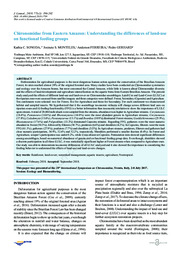Chironomidae from Eastern Amazon: understanding the differences of land-use on functional feeding groups.
Chironomidae from Eastern Amazon: understanding the differences of land-use on functional feeding groups.
Author(s): SONODA, K. C.; MONTELES, J. S.; FERREIRA, A.; GERHARD, P.
Summary: Abstract: Deforestation for agricultural purposes is the most dangerous human action against the conservation of the Brazilian Amazon Forest; its rates reached almost 20% of the original forested area. Many studies have been conducted on Chironomidae systematics and ecology over the Amazon biome, but most concerned the Central Amazon, while little is known about Chironomidae diversity and the effects of land development and agriculture intensification on the aquatic biota from Eastern Brazilian Amazon. The present study analyzed the effects of different land-use and land-cover on Chironomidae assemblages. Land-Use and Land-Cover (LULC) at the riparian zone were assessed from satellite imagery and three categories were defined: Forest, Secondary (Capoeira) and Agriculture. Ten catchments were selected: two for Forest, five for Agriculture and three for Secondary. For each catchment we characterized habitat and sampled insects. We hypothesized that i) the assemblage taxonomic richness will change across different land uses on riparian zones and ii) feeding functionality is a better information than taxonomic resolution to show the importance of LULC upon stream. A total of 20,884 individuals were sampled from the streams, abundance was higher in Agriculture streams. Corynoneura (18.4%), Pentaneura (14.6%) and Rheotanytarus (14.0%) were the most abundant genera in Agriculture streams; Corynoneura (17.8%), Caladomyia (13.6%), Paratanytarsus (13.1%) and Beardius (10.9%) dominated Forest streams; Goeldichironomus (25.9%), Rheotanytarus (17.6%) and Polypedilum (13.2%) dominated Capoeira streams. Regarding FFG, gatherers were the most numeric abundant in Forest (50.3%), followed by filterers (38.7%), predators (6.6%) and shredders (4.2%). In Capoeira, filterers were the main FFG (61.1%), gatherers (27.9%), predators (7.7%) and shredders (3.3%). In Agriculture streams, predators, filterers and gatherers had close numeric participation, 34.9%, 32.4% and 32.2%, respectively. Shredders performed a smaller fraction (0.4%). In Forest and Agriculture, scrapers participation was under 0.2%, while it was absent at Capoeira. Permutation tests showed significant differences among assemblages, based on numerical abundance of genera and on functional feeding group data. Even though, shredders showed a discrete participation in all three LULC, it was statistically significant higher at Forest streams when compared to Agriculture ones. Our study was able to demonstrate taxonomic differences of all LULC analyzed and it also showed the importance in considering the feeding behavior to understand the effects of land-use and land-covers changes.
Publication year: 2018
Types of publication: Journal article
Unit: Embrapa Environment
Observation
Some of Embrapa's publications are published as ePub files. To read them, use or download one of the following free software options to your computer or mobile device. Android: Google Play Books; IOS: iBooks; Windows and Linux: Calibre.
Access other publications
Access the Agricultural Research Database (BDPA) to consult Embrapa's full library collection and records.
Visit Embrapa Bookstore to purchase books and other publications sold by Embrapa.

